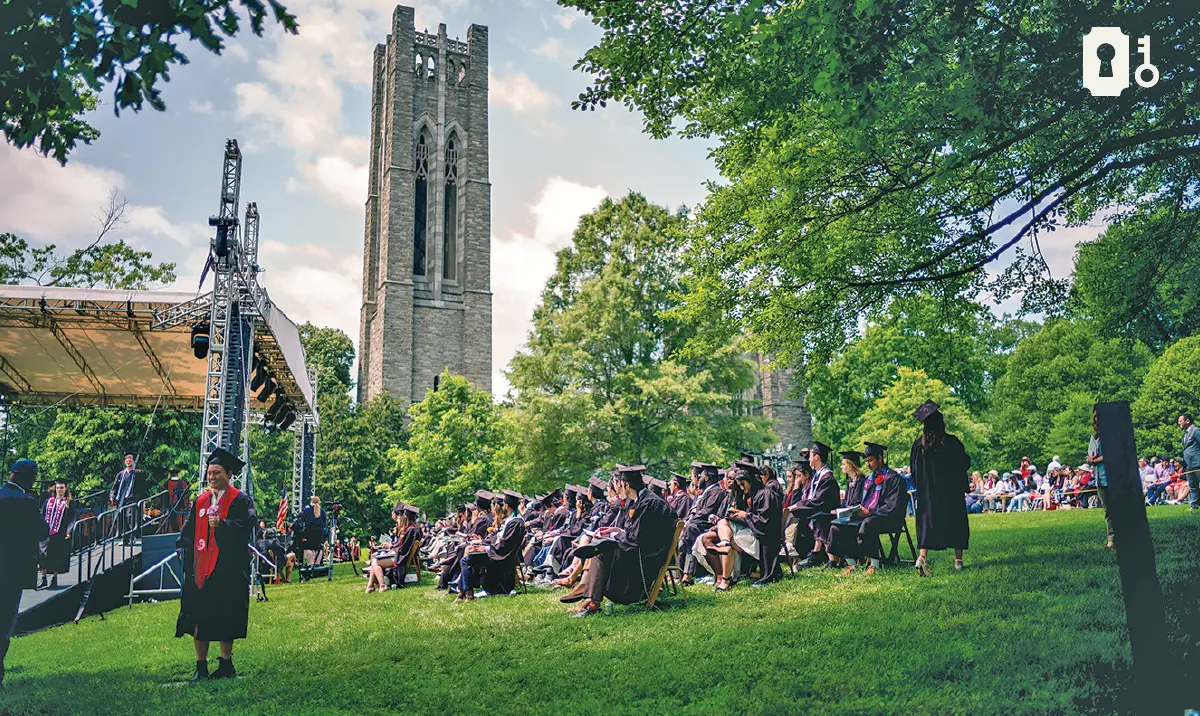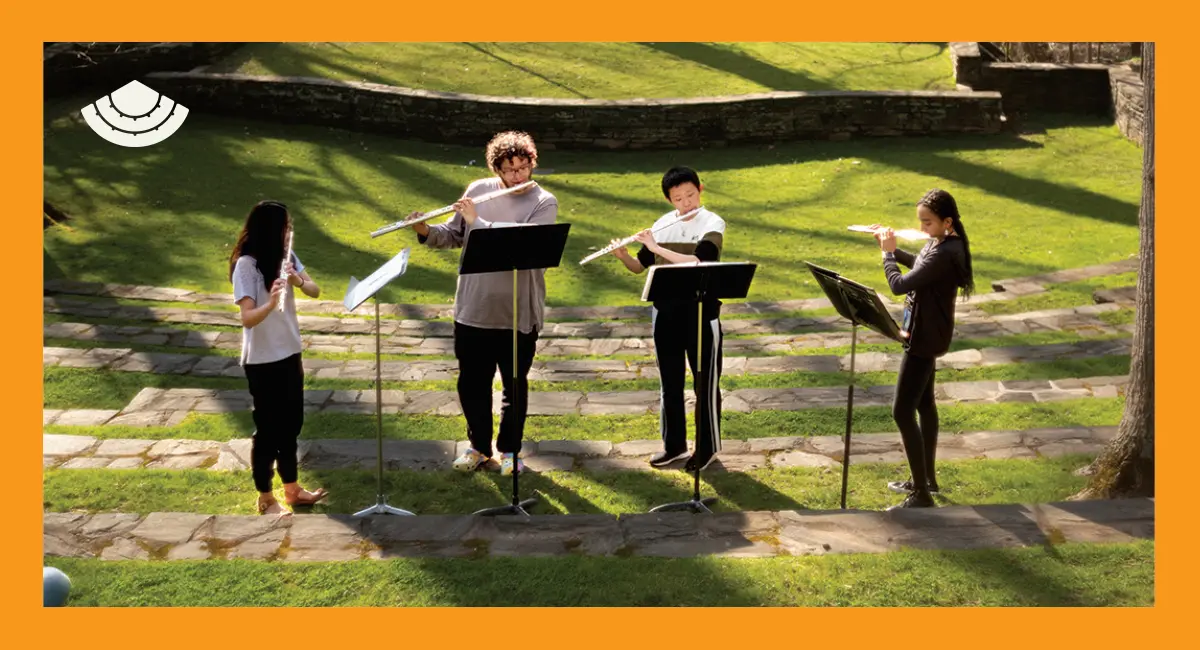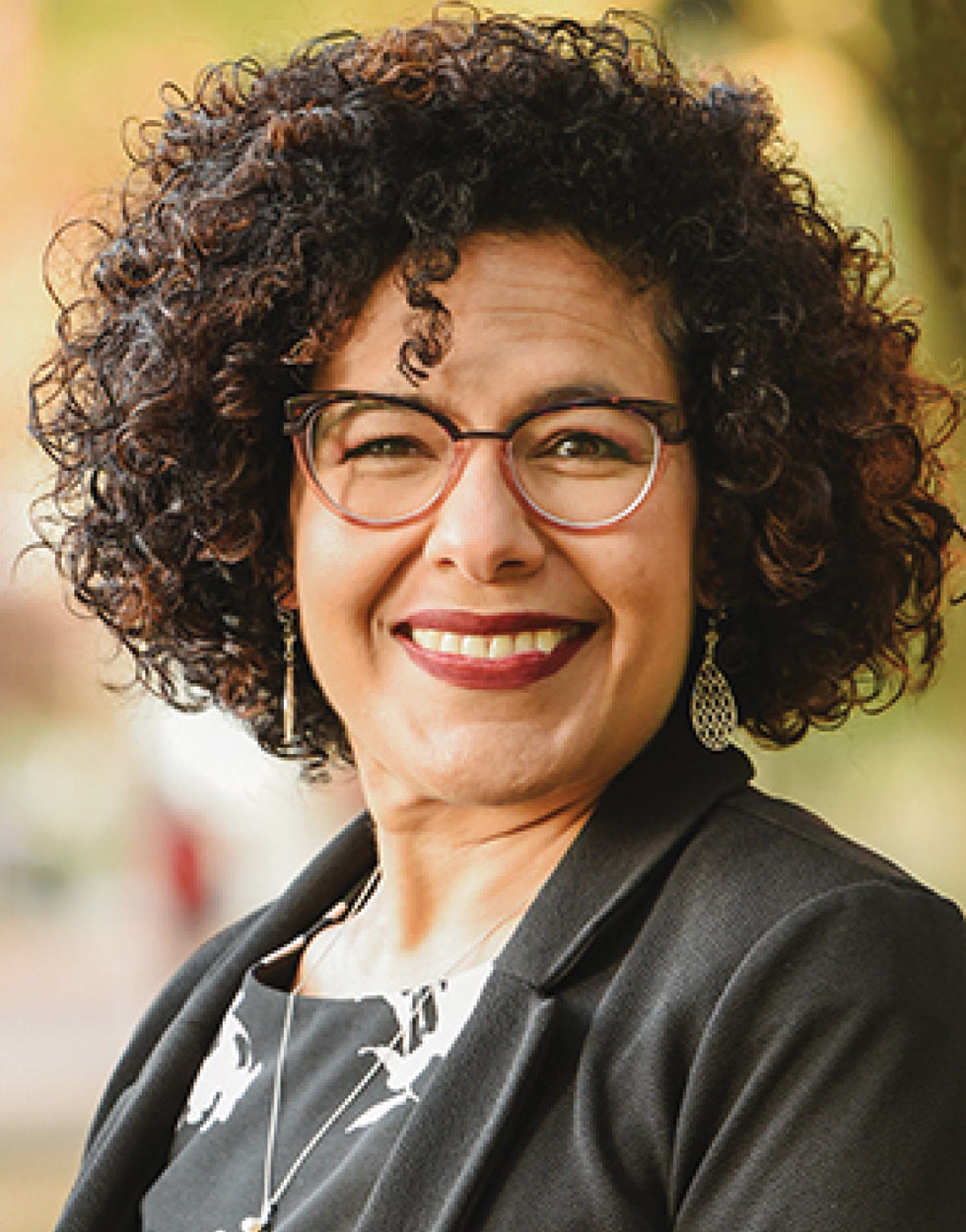Barbara Harris ’85
Heather Hightower ’09
The crane is often an international symbol of peace. (See pg. 83). Illustration by Mayuko Fujino
(See pg. 14)
Flight Patterns
campbell
Even in the shadow of atomic dust, art and the human spirit persevere.
With nations embroiled in wars and conflicts across the globe, our aim was to elevate. And nature led the way. Illustrator Mayuko Fujino’s crane inspires us to remain in a place of hope. “Seeing Change” (pg. 22) shares the stories of alumni working to “be the change they want to see,” committing to making it real in their daily lives. Offering insight across disciplines on the ongoing debates around war in the Middle East, our faculty ask difficult questions in “The Emotional Weight of Words” (pg. 38). They encourage students to do the same. Stories on art, at the end of this issue, refocus our conversations with an opera about Malcolm X and an exhibition on migration and war.
With so many earth-shaking concerns, a small moment with students this fall sustains. On a freezing Friday night in November, the Swarthmore Bird Club gathered at the Willistown Conservation Trust in neighboring Chester County. The van ride through lightless, twisty back roads brought about 15 students to a field station to explore how banding (a way to to identify and collect data) helps us understand more about the elusive northern saw-whet owl. With the staff’s guidance, the students learned about the species’ habitat, conservation status, and migratory behaviors. Then they had the chance to gently hold one of the diminutive raptors. They marveled, they smiled, they gazed into the bird’s round eyes.
But it was the release that was something to behold.
At the end of the night, the group tramped out into the dark field following the staff member who was holding the owl. They stopped near the woods’ edge. The rule was no talking. Not a sound. In frigid air, they waited for the tiny northern saw-whet to make its move. It was magic, in a way, to realize the students were so invested in learning about something new, and small, and often invisible — and that they were willing to gather in a field in silence to wait to watch the journey begin.
Then, soundlessly, the bird lifted off and flew headlong into the night.
swarthmore college bulletin
Andy Hirsch
Director of Content Strategy
Mark Anskis
Editor
Kate Campbell
Managing Editor
Ryan Dougherty
Editorial Specialist
Nia King
Class Notes Editor
Heidi Hormel
Designer
Phillip Stern ’84
Photographer
Laurence Kesterson
Administrative Coordinator
Lauren McAloon
Editor Emerita
Maralyn Orbison Gillespie ’49
Email: bulletin@swarthmore.edu
Telephone: 610-328-8533
We welcome letters on articles covered in the magazine. We reserve the right to edit letters for length, clarity, and style. Views expressed in this magazine do not necessarily reflect the opinions of the editors or the official views or policies of the College. Read the full letters policy at swarthmore.edu/bulletin.
Send letters and story ideas to
bulletin@swarthmore.edu
Send address changes to
records@swarthmore.edu
Printed with agri-based inks.
Please recycle after reading.
©2024 Swarthmore College.
Printed in USA.

On Our Radar
Pass the Pawpaws
Also the remembrances of centenarians. What a solid, remarkable group of people, humble, ordinary yet extraordinary. This year I lost my mother in that group (Moravian College “for Women” at that time, Class of 42) and an uncle/godfather (Lafayette College, all men at his time). Thank you for this. I will pass the pawpaw article onto horticulture friends.
—ANNE THOMPSON ’70, Silver Spring, Md.
The Pawpaw Connection
—PETER SCHMIDT, William R. Kenan, Jr., Professor of English Literature
Enthralling
My father, Paul Marshall James, M.D., ’29 had just established his general practice of medicine when war broke out following the bombing of Pearl Harbor. He was a lifelong Quaker, and at 34 years of age, would not have been drafted. However, he felt compelled to volunteer to serve in the Navy and did so for five years at considerable personal sacrifice. His first assignment was as ship doctor on an oil tanker in the Atlantic Ocean where German submarines were taking a great toll on American vessels.
His last assignment was to serve as the physician for the V-12 sailors at Swarthmore as well as taking care of the Chinese naval personnel who were also training at Swarthmore. To express their thanks for his care, the Chinese officers presented him with a wonderful picture made of bamboo depicting a small village in their country. This last assignment to serve at his alma mater proved to be meaningful, rewarding, and restorative to him. For that I am thankful.
—FRANK JAMES, M.D. ’57, Winston Salem, N.C.
Every Day Counts
The Swarthmore connection caused our now 40+ year friendship with Jan and her husband Bill Anderson to happen, as at a gathering at the Smithsonian she recognized my surname and asked if I might be related to a young man who was a year behind her at Swarthmore, the young man being my father, Daniel Ganister, Class of ’43. Our lives have been greatly enriched by our friendship with them ever since.
It was a joy to read about Mrs. Schneider’s Swarthmore memoir. I especially liked the picture of her at a Swarthmore football game. There is a good possibility my father was on the gridiron at that time.
I hope that the Bulletin will be a bit more careful before making tontim-like declarations. Both ladies (and any other surviving members of the Class of 1942) deserve our recognition. Three cheers for them all!
—RUTH E. GANISTER ’72, West Chester, Pa.

Let’s Talk
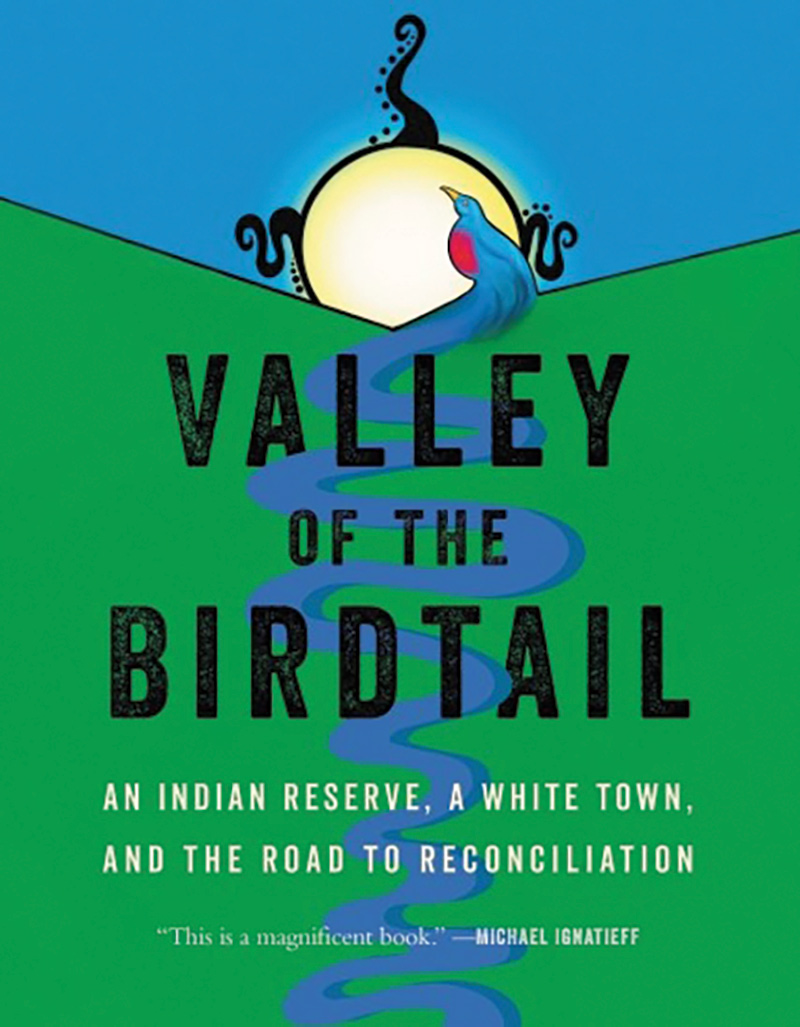
I expected the worst, of course. I was based at a fancy university in a big city and read all the highbrow newspapers deploring the usual suspects.
My work is about racism in Canada against Indigenous Peoples. It is tempting to give up on those who seem stuck in their thinking — we change our minds with difficulty, our biases and opinions so often calcifying over time.
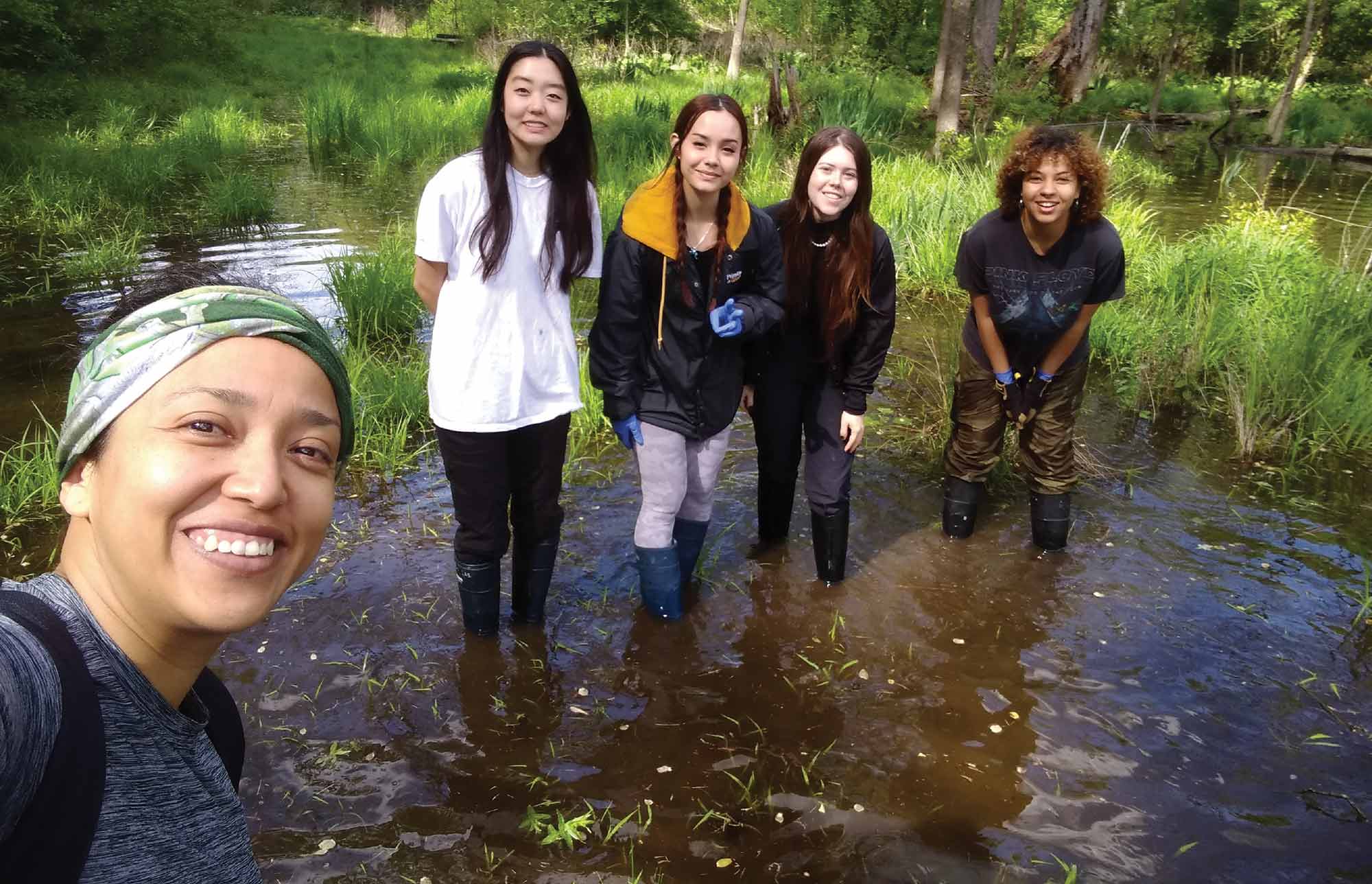
studentwise: frog focused
Though women have historically been underrepresented in the study of amphibians and reptiles, Aimi Holmes ’25, Stephanie Kim ’25, and Isabella Wyatt ’25, along with Bryn Mawr’s Leila N’Diaye ’24 are pursuing it under the canopy of Crum Woods and the mentorship of Assistant Professor of Biology Itzue Caviedes Solis.
They started by learning about Swarthmore’s native wildlife to gain insights about the state of the local environment and waterways. They focus on amphibians because they have incredibly permeable skin, making them excellent bioindicators. An amphibian’s health reflects the health of its ecosystem.
Submit your publication for consideration: books@swarthmore.edu
HOT TYPE: New releases by Swarthmoreans
Peter Biskind ’62
Pandora’s Box: How Guts, Guile, and Greed Upended TV
Harper Collins
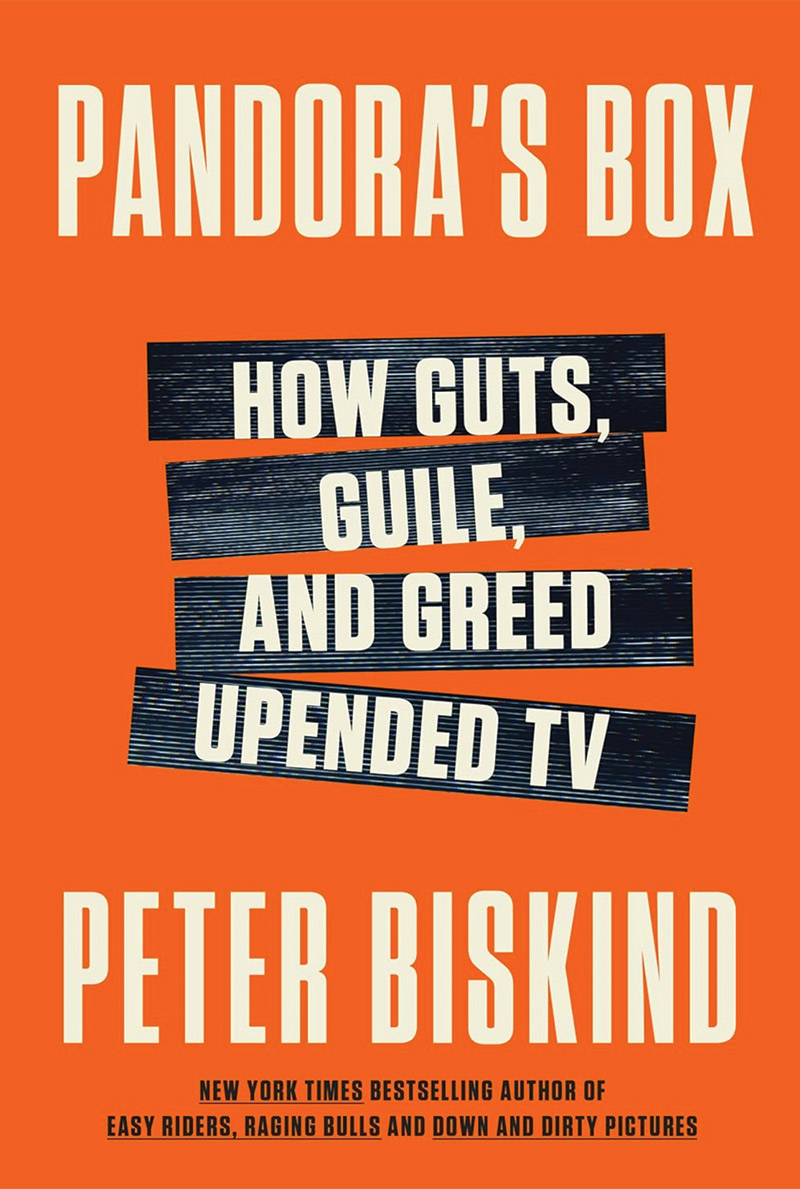
Cleveland Justis ’91 and Daniel Student
Don’t Lead Alone: Think Like a System, Act Like a Network, Lead Like a Movement!
Fast Company Press
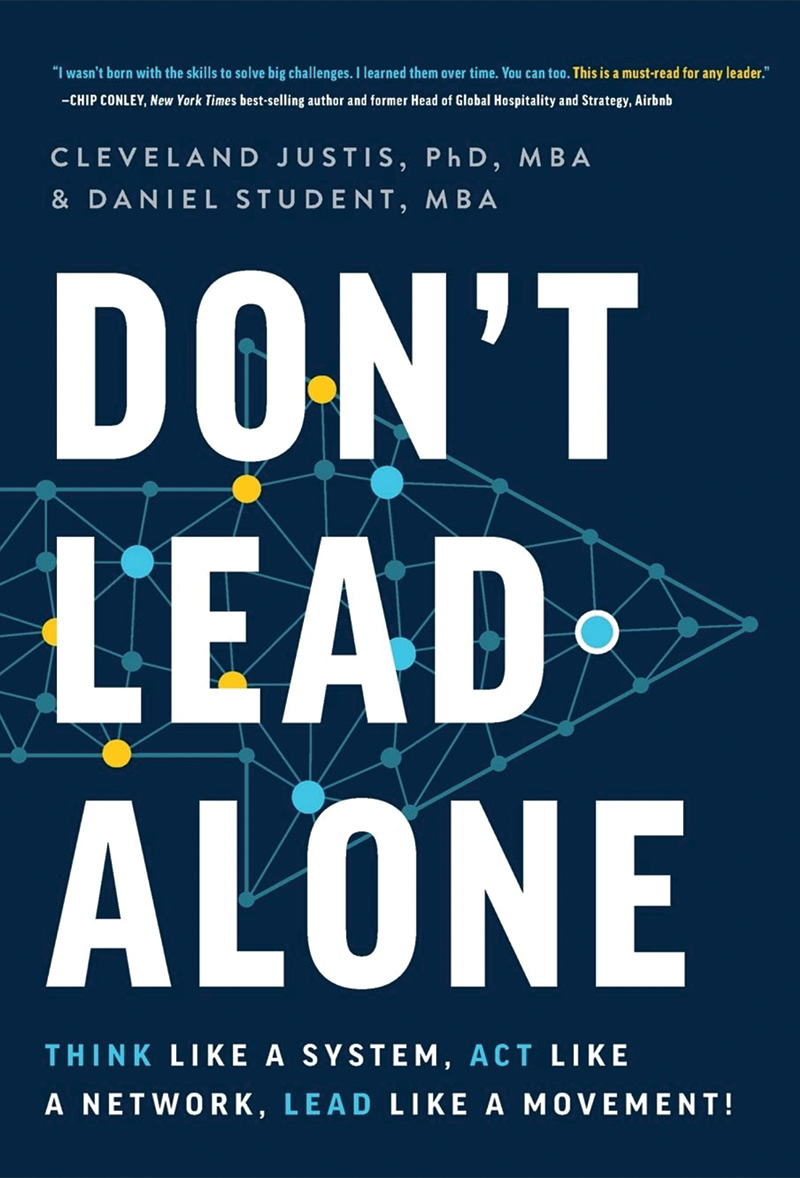
Suppressed Through Subtle Means
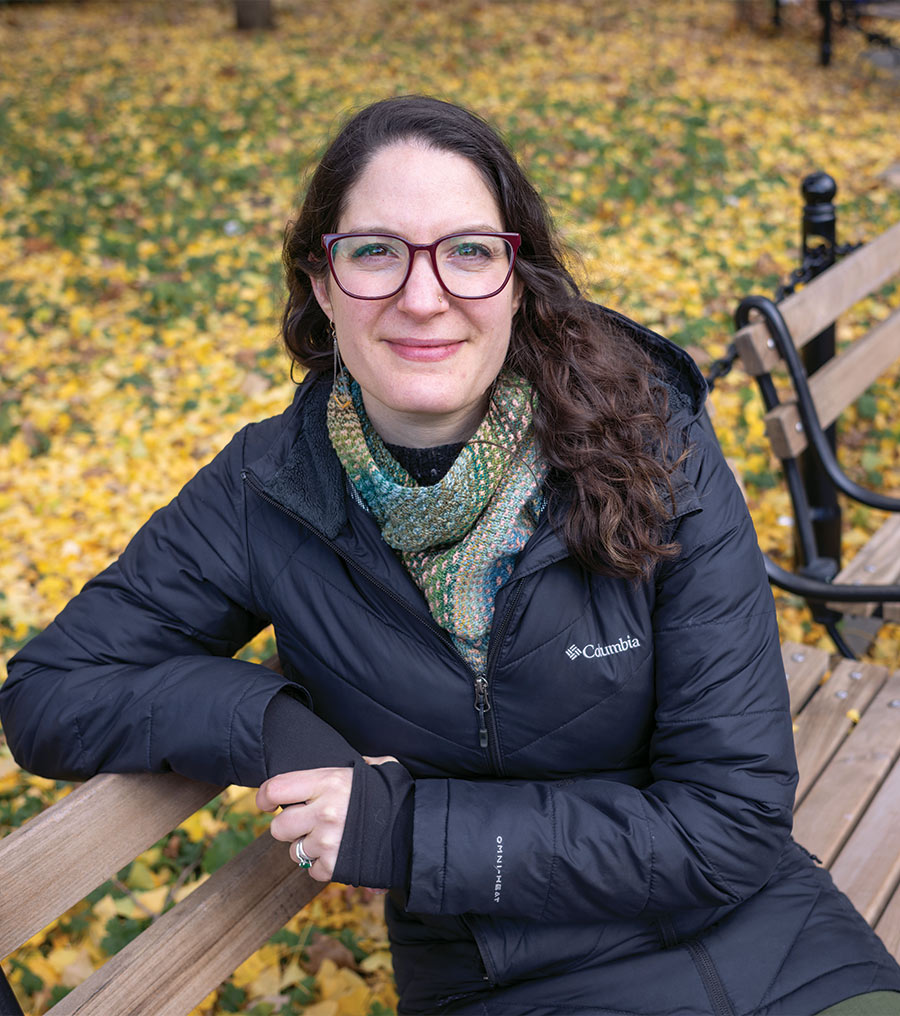
In addition to her work for Scholars at Risk, a New York University-based organization focused on global academic freedom, Kapit also works closely with the Norwegian Students’ and Academics’ International Assistance Fund, for which she produced a recent report highlighting four mechanisms of supression of student protesters. One of these is delegitimization — “the framing of students as troublemakers, rabble-rousers, violent criminals.”
sharing success and stories of swarthmore
common good
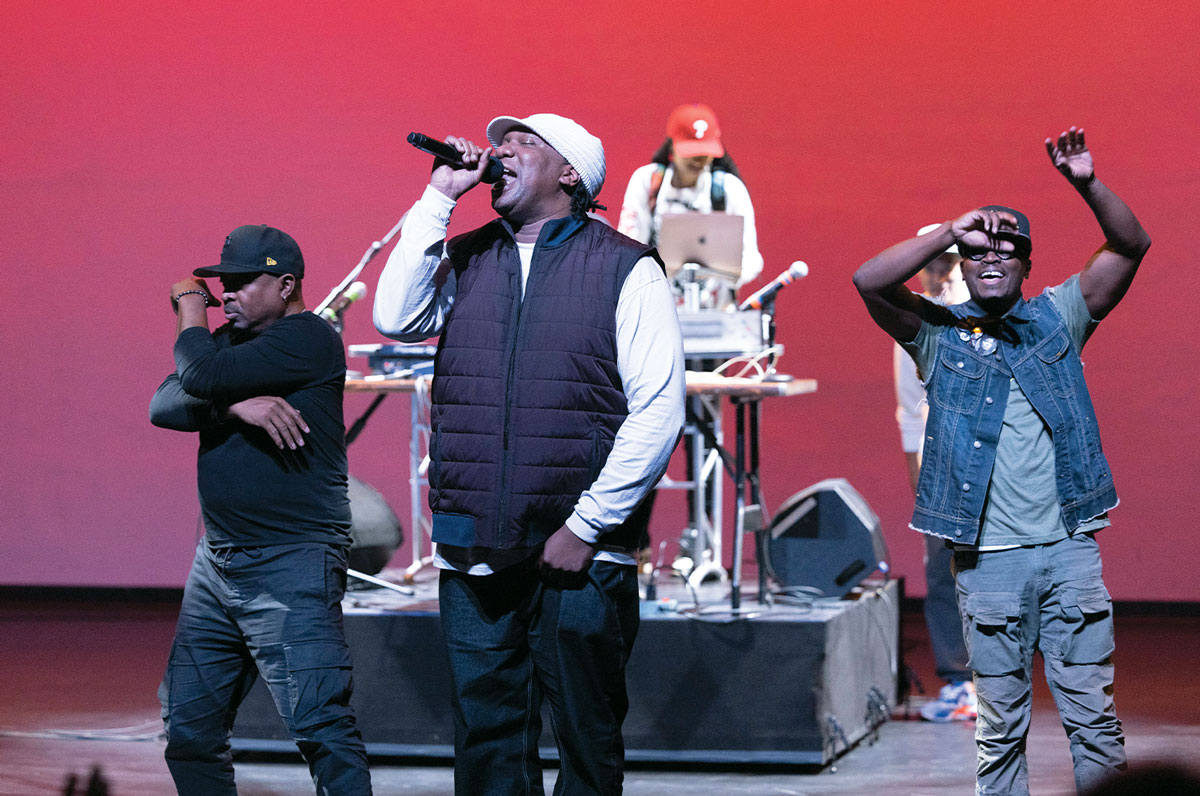
Icons on the Mic: Hip-Hop Turns 50
The kickoff Oct. 6 started with hip-hop icons Chuck D, KRS-One, and Wise Intelligent discussing cultural sustainability and political resistance in front of a capacity crowd in Pearson-Hall Theatre in the Lang Performing Arts Center. It was followed by a talent exhibition with all three artists and the renowned hip-hop dance company Urban Artistry.
—RYAN DOUGHERTY
Zine Scene
hough anything self-published can be called a zine, the word implies a certain scrappiness that differentiates a zine from its more glamorous cousin, the glossy, ad-filled magazine. Scholarly Communications Librarian Maria Aghazarian calls it a “punk ethos.”
“Zines can be free, or traded without currency, and often are informative,” she says. There are zines about knowing your rights if you’re stopped by the police, for example. Swarthmore’s zine collection in McCabe Library is largely donated and includes about 200 publications. The collection creators, Aghazarian and Nooria Ahmed ’22, curated for diversity from the very start. At McCabe, “we were really lacking both independent publications and independent voices [in the comics collection],” says Aghazarian. “Noria came up with the idea of creating a zine library as a way to balance that, and to highlight really diverse and local voices.”
Zine-makers explore whatever topic interests them. “Some are fantasy, some are realistic, some are just purely art with no words,” says Aghazarian. As an extension of the participatory, punk ethos of zine culture, anyone can donate to the collection.
The Sager Series is offering a ZOOM panel of queer and trans zinesters and comic artists, March 21 from 6-8 p.m.
The panel features Cristy C. Road, Vo Vo, Joe Hatton, and Sawyer Lovett, who all have work in the Swarthmore Zine Collection, and will be moderated by Nia King. Register here: bit.ly/3FcAKAE
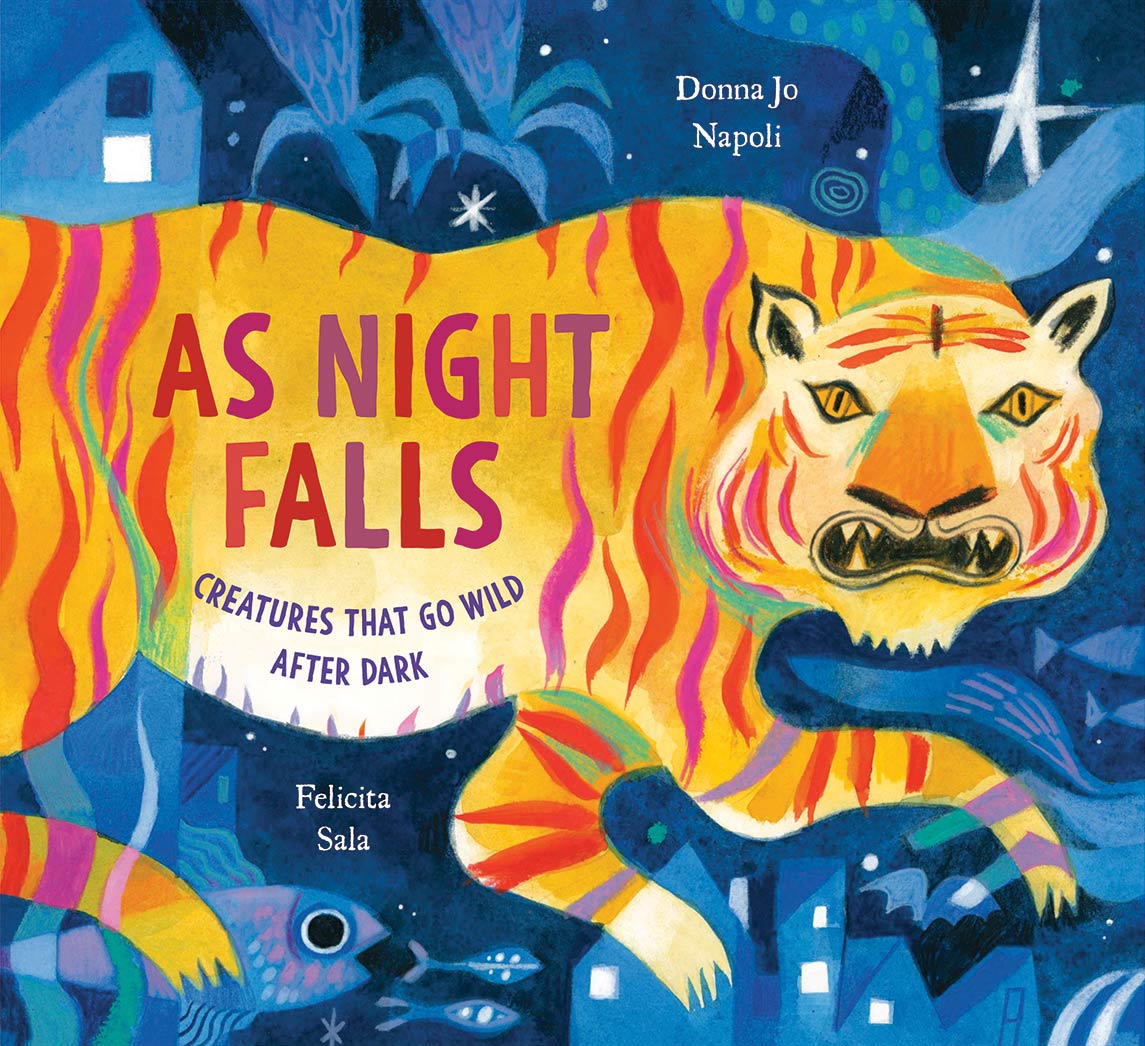
A Lifetime of Linguistics
Professor of Linguistics and Social Justice Donna Jo Napoli is the 2024 recipient of the Victoria A. Fromkin Lifetime Service Award (LSA). This Linguistic Society of America award recognizes individuals who have performed extraordinary service to the discipline of linguistics and the Society throughout their career.
Napoli, who joined the College faculty in 1987, is a renowned author and linguist who works to protect deaf children’s right to language.
In Spring 2024, Napoli will teach Supporting Literacy Among Deaf Children, and co-teach (Dis)ability: Perceptions and Music, and Defying Categorization: Contemporary Dance and Sign Language Performance. In Fall 2024, she will teach Sign Language Literature from a Linguistics Perspective and How Children Talk to Each Other: Oral and Written Language. In addition to her work at Swarthmore and with the LSA, Napoli has co-written or co-edited 19 books and 124 articles in linguistics. She’s also written, co-edited, or contributed to six poetry books, written 23 publications on creative writing, and worked on over 90 children’s and young adult books.
We’re All Interwoven
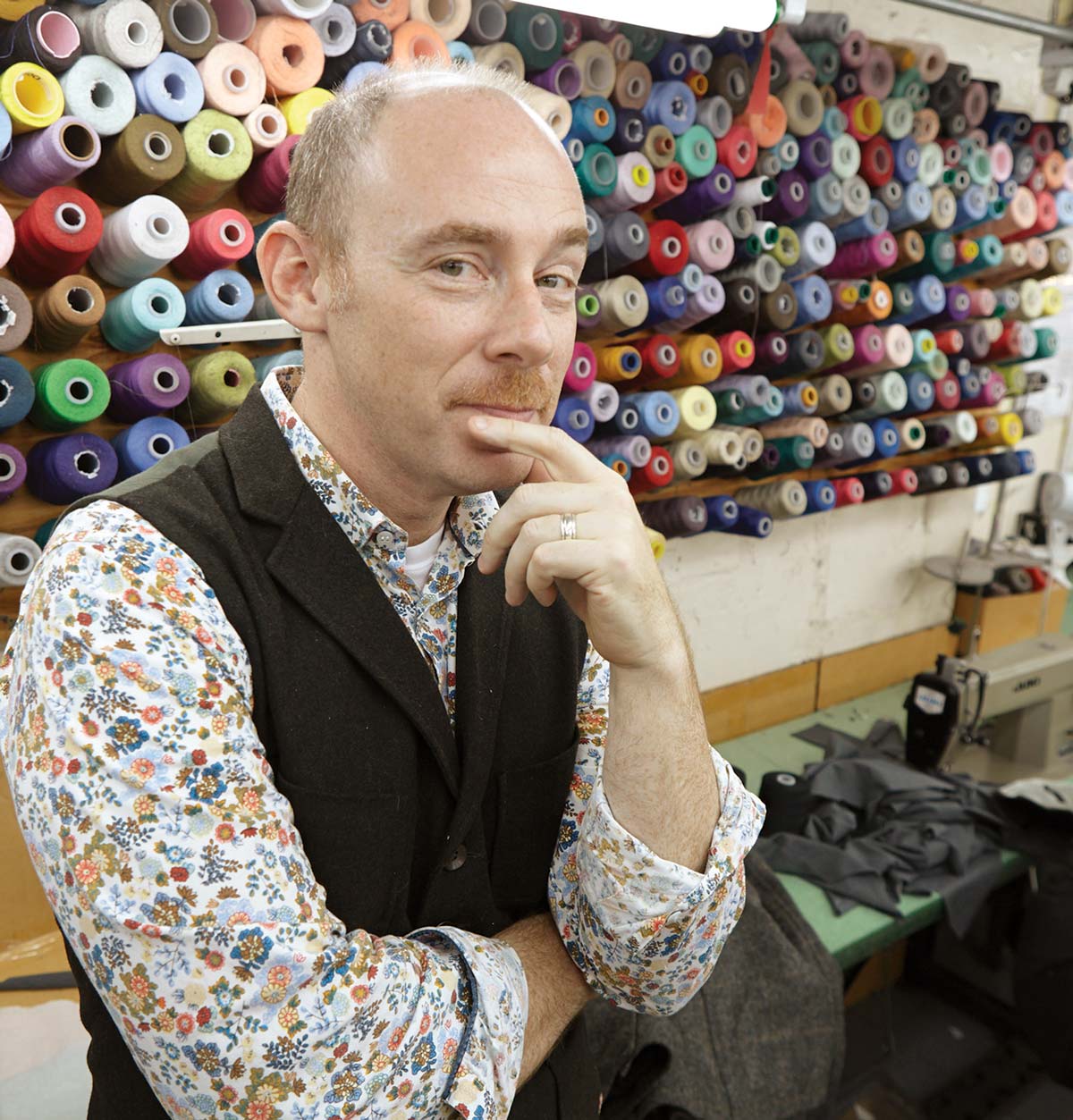
He’s now been at FIT for 23 years, working his way up from communications specialist to chief storyteller. Over that time, he’s come to understand the complexities of the industry.
“When you buy a piece of clothing, you are connected to so many people, whether you understand those relationships or not,” says Joseph.“You’re connected to the person who designed it, the person who made it, the people who shipped it. You’re connected to the materials and the green issues that your garment raises.”
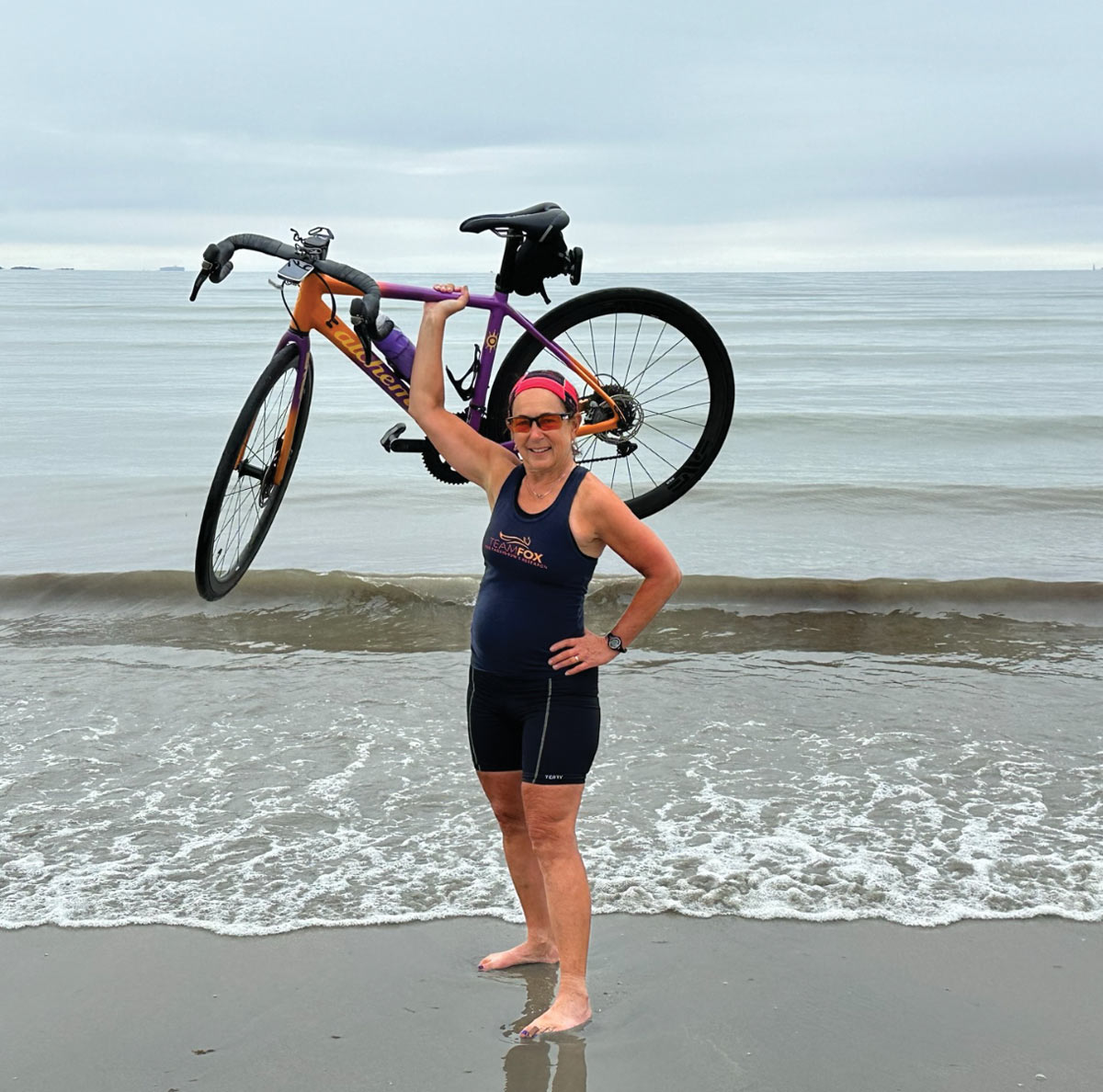
Coast To Coast For A Cure
Her journey from Los Angeles to Boston last spring took 49 days. It was a tribute, Harris says, not only to her parents, but to the millions of people constricted, confined, and immobilized by Parkinson’s disease.
The disease sadly defined their last years, she says. “That was just when they had the time and resources to travel more freely, something they always enjoyed.”
Harris decided a coast-to-coast ride on a custom-designed carbon fiber Alchemy Helios was a fitting way to honor her parents’ lives. The ride was not Harris’ first impressive feat to support Parkinson’s research: She climbed Mt. Kilimanjaro 10 years ago and raised more than $25,000 for the cause.
“While the genetic connection to the disease is not definitively known, I have a vested interest in a cure being found,” says Harris.
Harris spent several years planning and training for for the U.S. trip. In January 2023, she worked with a coach, and then she took two months away from work for the ride.
Her family supported her solo, seven-week sojourn. One of her daughters organized a send-off dinner for her in Los Angeles. Though she was away from her husband, Ben Woloshin, for the majority of that time, he and her other daughter flew to Santa Fe, N.M., and met her at the finish line in Boston with their dog.
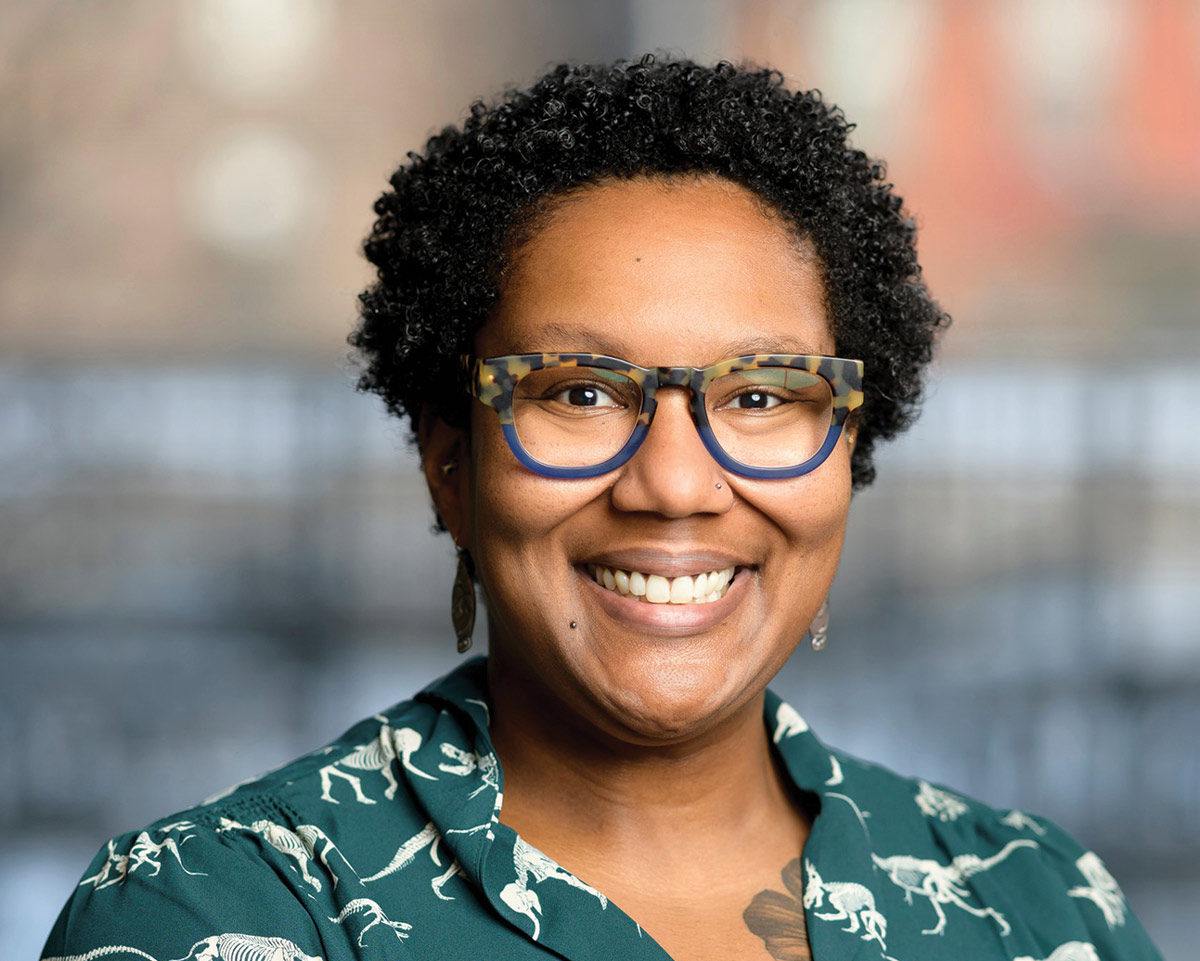
breaking down barriers
“I used to work pediatric oncology at the bedside. Patients come in with cancer and you’re treating them and they’re acutely ill. I did that through the pandemic and got a little burnt out,” says Hightower. “We started a new program called the Adolescent and Young Adult Program. That focuses on patients who are between the ages of 15 and 39, providing additional support to them.”
The needs of this age group are very different. In addition to trying to beat cancer, they’re trying to figure out high school and college, careers, and possibly starting a family.
“I try to facilitate getting them additional resources,” says Hightower, from help with child care to selecting an insurance provider. That’s the advocacy part. The education and translation comes in when Hightower explains to patients, “This is what this means when a doctor is saying this, this is how you read your labs, this is how you figure out how many pills to take each day.”
As a Black nonbinary nurse, Hightower also focuses on health equity.
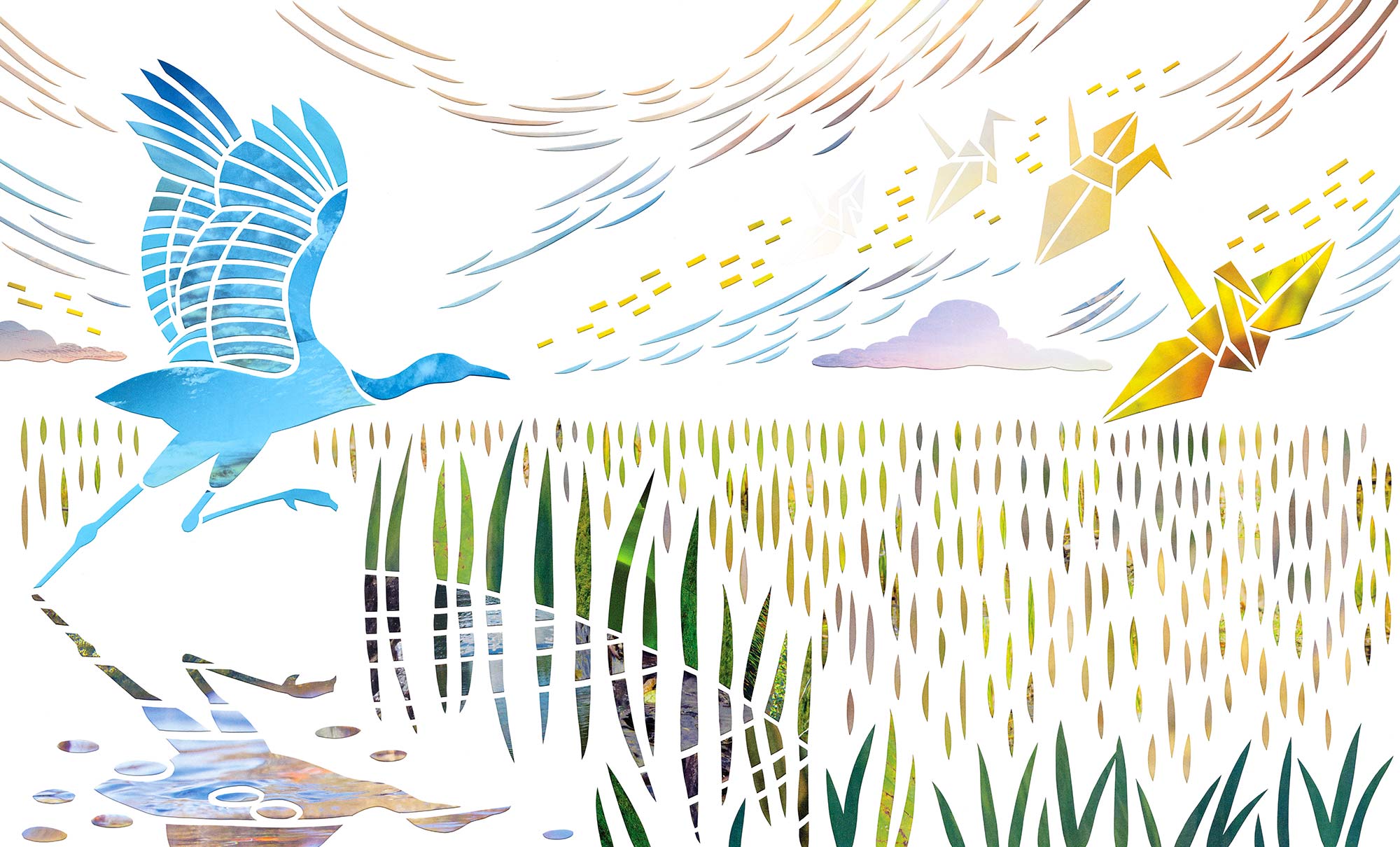
Seeing Change
Feeling gratitude in the face of crisis
Based in Rome, she is supporting the World Food Programme’s (WFP) efforts in Sudan, Chad, Gaza, and DRC, she says. “I have deployed members of my rapid response team to those locations and I attend bi-weekly operations meetings to discuss what is needed.” The WFP won a Nobel Peace Prize in 2020. Its relief efforts in 120 nations reached 160 million people in 2022. Oman Lawi’s humanitarian work began at Swarthmore, where she had a special major in anthropology, sociology, and religion. “I called it peace studies,” she recalls. While a sophomore, the amount of food wasted at the former dining hall troubled her. Soon she began taking plastic tubs full of leftovers to a Chester homeless shelter in her Chevy Tracker. Later, she created a feeding program on 69th Street in Philadelphia.
Can Peace Building Be Taught?
LAURENCE KESTERSON
“has changed everything about how I teach, try to co-create communities of learners in the classroom, and support students through their own development,” says Johnson.
The Pathfinder
“I was very young, maybe 4 or 5,” says Johnson, who also teaches in the Black Studies and Peace & Conflict Studies departments. “But I remember very vividly [a man] who had been incarcerated. He was somebody my father mentored and loved deeply. When he came home from Attica, he stayed with us. We just adored him. So it was never something that I was afraid of. My parents taught that we cannot be reduced to our worst moment. We are all so much more. More importantly, it isn’t about the choices we make, it’s about the choices we have. The outcomes we are seeing are the result of the social, political, and economic conditions that have been created by those in power.”
The Emotional Weight of Words
photos by Laurence Kesterson
Beware Simplistic Frameworks
Dominic Tierney, Political Science
Multiple things can be true at the same time: Hamas is a brutal and extremist group that committed appalling atrocities, and Israeli governments have made choices that oppressed Palestinians and closed off pathways to a Palestinian state.
We should beware a “zero sum” view of grief where admitting the sorrow felt by the other side is seen as diminishing the moral clarity of the “cause.” Otherwise, good people can end up apologizing for atrocities and seeing truth in terms of who it benefits.
AN AMERICAN CLASSIC
HE DAY after he retired from his job as an insights director for a market research firm in Manhattan, Christopher “Kip” Davis ’75 wasn’t worried about being bored.
Instead, he rushed downtown to attend rehearsals for the opera he’d helped to write in the mid ’80s. X: The Life and Times of Malcolm X opened at the Met on Nov. 3, 2023.
The project was inspired by his years at Swarthmore. Davis had taken Chuck James’s African American Autobiography course in the spring of 1974. “We read an amazing array of books, but I was especially taken with The Autobiography of Malcolm X,” he says.
He called his older brother, Anthony, who was studying music at Yale, and said, “We’ve got to write a music theater piece about Malcolm. There’s so much music in his story.” Davis saw parallels between Malcolm X’s spiritual journey and the spiritual journeys of jazz musicians in the late ’50s and early ’60s.
Manifesto of the Unsung
he air fairly crackles with energy as Ninotchka Bennahum ’86 and Bruce Robertson ’76 describe the rigorous, Socratic-seminar-style debate that characterizes their collaborative process. “We argue a lot. We’re good at it,” says Bennahum.
The two friends, colleagues at the University of California-Santa Barbara, where Bennahum is director of dance studies in the Department of Theater and Dance, and Robertson is is Professor Emeritus, History of Art & Architecture, approach historical material very differently. They ground their lively exchange of ideas in interdisciplinary research, a commitment to pedagogy, respect for their subject and one another, and an overarching passion for social justice. Border Crossings: Exile and American Modern Dance, 1900–1955 at the New York Public Library for the Performing Arts at Lincoln Center is the third major exhibition they’ve curated over 12 years of working together.
Deconstructing traditional dance modernism requires strong documentation, but “dance is focused on elusive imagery: a dancing body that appears to disappear … gone after the moment of performance,” says Bennahum. When they discovered photos by Carmen Schiavone from 1947 of Katherine Dunham on a Cuban tour, “leaping and dancing in nature in the most profoundly liberated fashion,” says Robertson, “we knew we had an exciting exhibition.”
Re:living history
usan Marie Frontczak ’77 engineers stories. Over more than two decades, this computer designer-turned-living-history scholar has given more than 875 performances abroad and in almost every U.S. state.
She likes to joke that she travels with “my ladies” — performing as Red Cross founder Clara Barton, dancer Irene Castle, scientist Marie Curie, First Lady Eleanor Roosevelt, author Mary Shelley, and humorist Erma Bombeck.
The passion for precision this engineering major brings to her roles befits a person who created integrated circuits and medical software for Hewlett Packard for 14 years. After a year’s sabbatical from HP and more time honing her craft, Frontczak spent two years developing her first historic persona — Curie, the discoverer of radium and two-time Nobel Prize winner.
Reading a biography of Curie when she was 10 inspired Frontczak to become an engineer. At Swarthmore, only three other women shared her major. Curie inspired her to conquer tough courses.
class notes

OUT AND ABOUT
This fall alumni, families, and friends joined College leadership in Boston and New York City to hear updates from campus from President Val Smith, learn about current initiatives from faculty and key administrators, and reconnect with Swarthmore friends and classmates.
Attendees at the Oct. 30 event in Boston heard about recent successes in athletics and new initiatives in support of well-being on campus from Provost and Dean of the Faculty Tomoko Sakomura and Marian Ware Director of Athletics, Physical Education, and Recreation Brad Koch.
At the New York City event Nov. 1, Vice President for Student Affairs Stephanie Ives spoke about the College’s commitment to educating the whole student. Visit swarthmore.edu/SIYC to explore photo galleries and learn about upcoming Swarthmore in Your City programs.
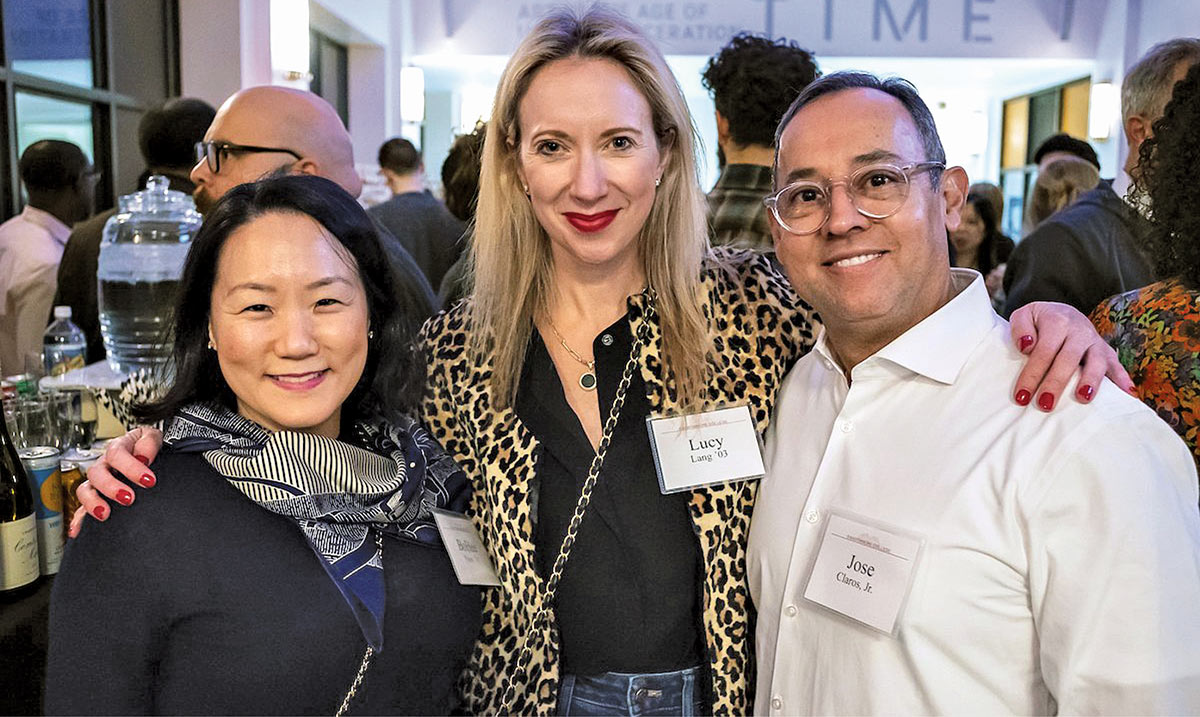
Your support makes a Swarthmore education extraordinary and accessible.
Your support makes a Swarthmore education extraordinary and accessible.

their light lives on
-
William “Bill” N. Hayes GR
Bill, a retired professor and lifelong pacifist, died Aug. 18, 2023.
Bill earned an associate’s degree at Lees-McRae College, a bachelor’s at the University of North Carolina−Chapel Hill, and a Ph.D. in psychology at Princeton University. He also did graduate work at Swarthmore from 1956−58, where he met and married first wife Johanna Metzger ’59. By 1973, Bill was the chairman of the Psychology Department of Albion College and helped to develop its first human sexuality course and another on drug abuse and treatment, retiring in 2000.
-
Edith “Edie” Graef McGeer ’44
Edie, who made profound contributions to the fields of neuroscience and Alzheimer’s disease research, died Aug. 28, 2023.
After graduating Phi Beta Kappa with Distinction at Swarthmore, she completed her Ph.D. at the University of Virginia, was a research scientist, married, and moved to Vancouver, Canada, eventually working at the Kinsmen Lab for Neurological Research at the University of British Columbia with colleagues including husband Pat. They eventually became a world-renowned research team on neurodegenerative disorders, producing three books, over 1,000 refereed publications, 10 patents (the latest granted after Edie’s 90th birthday), and over 100,000 citations.
-
Jane Ludemann Andrews ’45
Jane, a retired research assistant and mother of six, died July 25, 2023.
She earned a bachelor’s degree in political science at Swarthmore, followed by two master’s from the University of Delaware: one in human development in 1976 and another in liberal arts in 1995. Married to the late Robert K. Andrews ’44, Jane was a retired research assistant at the Winterthur Museum.
-
John R. Wenzel ’47
John, who fought the Nazis and for justice and equality, died Oct. 2, 2023.
A WWII fighter pilot, he finished his education at Swarthmore, earning an economics degree, followed by work at Chase Manhattan Bank and Ideal Corp., an automotive parts manufacturer, eventually becoming its president. When Parker Hannifin Corp. acquired Ideal, John became a division president, and as a member of the Motor and Equipment Manufacturers Association, called for the automotive industry to develop a comprehensive energy policy. After retiring in 1986, he began to paint again and, with his wife, fought for equality and justice.
-
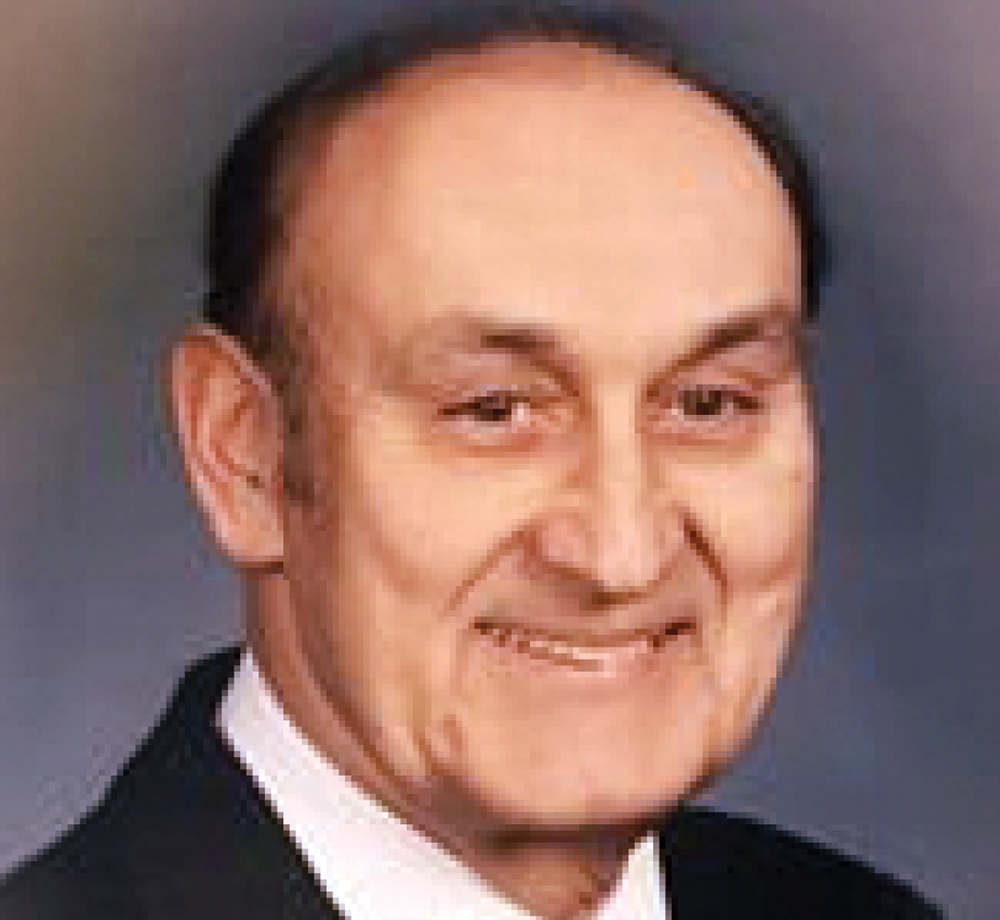 Stephen “Steve” Mucha ’49
Stephen “Steve” Mucha ’49Steve, who helped develop a 3D camera and the tandem-rotor transport helicopter, died Oct. 18, 2023.
After graduating with an engineering degree from Swarthmore, he started his own company, serving as a manufacturer’s representative. During his WWII Navy service, Steve helped create a type of 3D camera, then worked on the first successful tandem-rotor helicopter. Over the years, he was involved with photography, community theater, and sports, as well as playing dulcimers, autoharps, and with the Greater Pinelands Dulcimer Society. He also read to schoolchildren with the BookMates program.
looking back
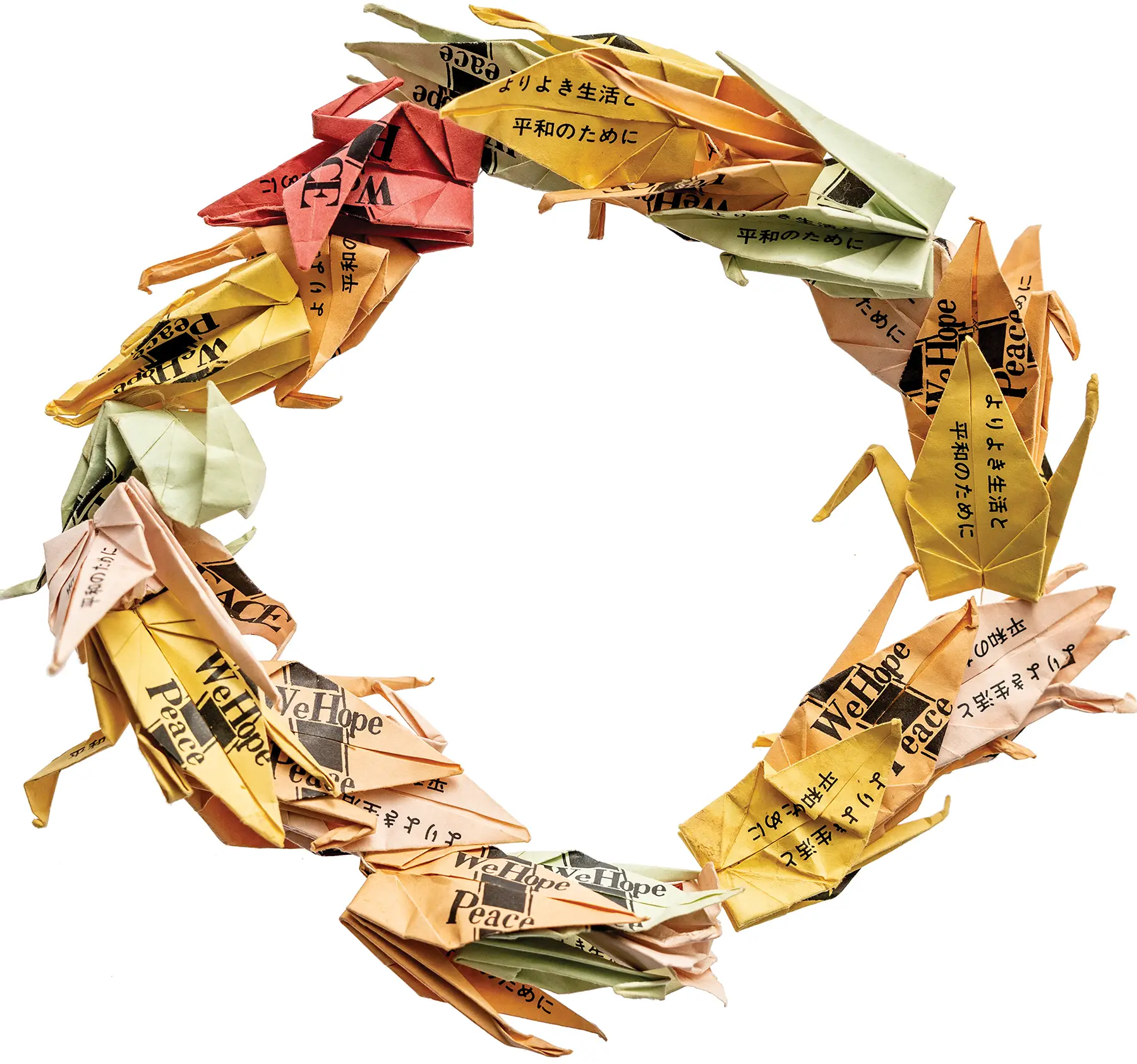
photo by laurence kesterson
1,000 Paper Cranes
Though she initially appeared unharmed, she developed leukemia 10 years later as a result of radiation exposure from the bomb.
In Japan, cranes are a symbol of long life. While in the hospital, Sadako learned about the tradition of senbazuru, folding 1,000 paper cranes to have a wish granted, which dates back to the late 17th century.
She began folding origami cranes using the little papers that held her medicine and any other paper available. According to her older brother, she folded over 1,300 cranes before she died on Oct. 25, 1955, only eight months after her diagnosis.
Today, a statue of Sadako holding a paper crane stands on top of the Children’s Peace Monument in Hiroshima’s Peace Memorial Park. Sadako’s story spread through the world, popularizing the paper crane as a symbol of the peace and anti-nuclear movements. Almost 10,000 are left at the Peace Monument each year.
This paper crane wreath was donated to the College’s Peace Collection by the family of peace activist Milton Lowenthal, a sponsor of the Japanese anti-nuclear artist Kazuaki Kita. You can find more artifacts of Lowenthal’s activism — including correspondence with Kita, audiocassettes, and posters — in the Peace Collection.
—NIA KING
photo by laurence kesterson

A WIDENING SCOPE
What about your new role appealed to you?
I thought it would be fun to take on some new challenges. Working with faculty to make sure they have the resources to support students, to think about our policies and whether there are areas where we can improve, has been exciting.
What does your most recent work with NASA entail?
I’ve received two grants recently related to a small NASA mission, the Transiting Exoplanet Survey Satellite. It’s surveying the whole sky and searching for planets around other stars. I’m part of a big team connected with that mission and especially follow-up observations here on the ground.

A NATURAL ENVIRONMENT
Swarthmore’s Bird Club learned about the migration patterns and overall health of the northern saw-whet owl. The student group was part of a volunteer effort in November at the Willistown Conservation Trust in Chester County, Pa. Holding a saw-whet owl is biology major Richard Garcia ’24. (Birds were handled and banded for research purposes under state and federal permits.)

A NATURAL ENVIRONMENT
Swarthmore’s Bird Club learned about the migration patterns and overall health of the northern saw-whet owl. The student group was part of a volunteer effort in November at the Willistown Conservation Trust in Chester County, Pa. Holding a saw-whet owl is biology major Richard Garcia ’24. (Birds were handled and banded for research purposes under state and federal permits.)
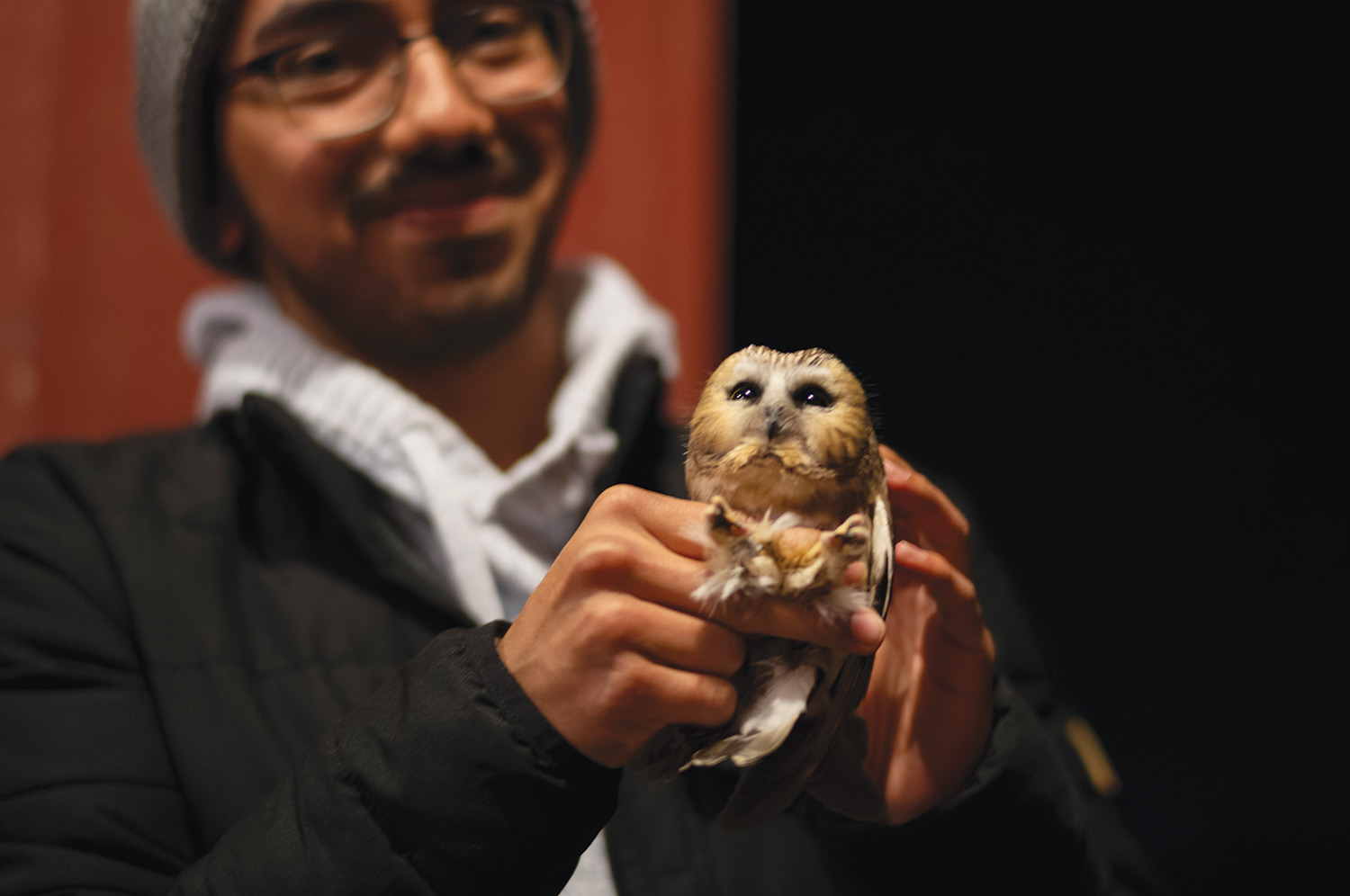
Back cover
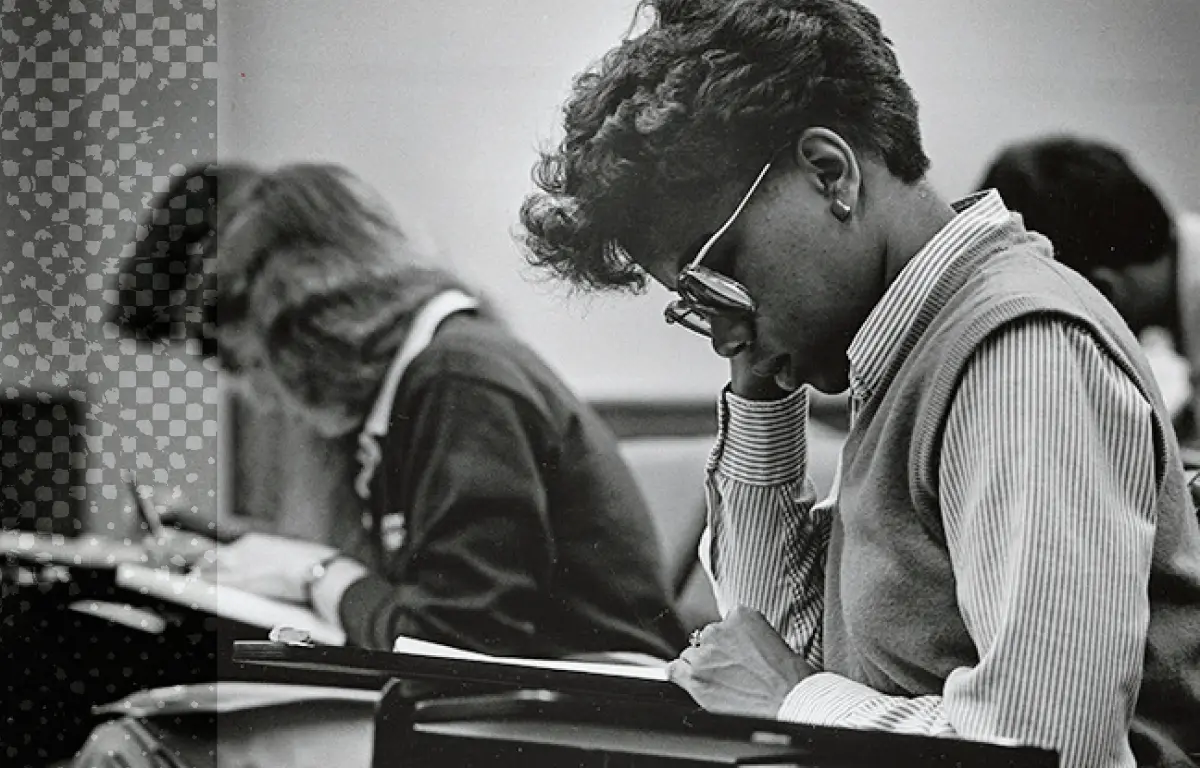

DO YOU HOLD THE DOOR OPEN FOR THOSE BEHIND YOU?
